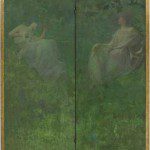What to See This Month
By • September 12, 2013 0 998

Regrettably, there are always going to be more museum exhibitions than any one patron can really keep up with. This month, however, our city is overflowing with visual art. From contemporary multicultural work to 17th-century Japanese paintings, and from Georges Braque to Southeast Asian textiles, there is a dazzling variety of gorgeous, historic and important museum exhibitions opening around us. Here are some of this month’s highlights.
The Phillips Collection
Georges Braque and the Cubist Still Life, 1928 – 1945
June 8 – Sept. 1
This exhibition is the first in-depth study of still life in Georges Braque’s (1882–1963) career framed within the historical and political context of 1928 to 1945. The show charts Braque’s work in this genre from intimate interior scenes of the late 1920s that he made alongside Picasso, to vibrant large-scale canvases of the 1930s, and finally to darker and more personal interpretations of daily life in the 1940s. There is not a more suitable museum for this exhibit in Washington, as The Phillips Collection founder Duncan Phillips played a pioneering role in introducing European modernists like Braque to American audiences. In his lifetime, Phillips acquired many works by Braque and presented his first U.S. retrospective in 1939. www.PhillipsCollection.org
Textile Museum
Out of Southeast Asia: Art That Sustains
Through Oct. 13
Southeast Asian textiles first served as markers of ethnic identity, distinguishing neighboring communities by pattern, color, and technique. While commercial production now challenges these practices, the artistic wealth of these several hundred groups continues to inspire artists from around the world. This exhibition explores historical textile artworks—including batiks from Indonesia and brocades and ikats from Laos—alongside the work of four contemporary textile artists and designers: batik artists Nia Fliam, Agus Ismoyo and Vernal Bogren Swift, and weaver Carol Cassidy. All of their works originate in Southeast Asian concepts, realized in certain design elements, technical details, and philosophical underpinnings. Out of Southeast Asia demonstrates how contemporary artists are preserving the traditional arts even as they interpret them in new and innovative ways. www.TextileMuseum.org
Art Museum of the Americas
Fusion: Tracing Asian Migration to the Americas
June 13 – Sept. 15
The AMA’s permanent collection is one of the most vital sources of modern and contemporary Latin American and Caribbean art in the United States. The work on display in this exhibition generates a dialogue about cultural diversity by exploring the migration of artists or their families to the Americas from Asia during the second half of the 19th century and the first half of the 20th century. By addressing the multiple layers of cultural exchange, this exhibition aims to enhance understanding of the complex nature of modern Latin American and Caribbean societies, and to illuminate the social and cultural contributions that this multiculturalism has generated. www.Museum.oas.org
Freer | Sackler
Sylvan Sounds: Freer, Dewing and Japan
Through May 18, 2014
Museum founder Charles Lang Freer’s taste for Japanese art grew out of his affection for American tonalist paintings, notably the artist Thomas Dewing (1851–1938). This intimate exhibition illuminates this connection by juxtaposing Dewing’s landscapes with Japanese works that Freer acquired in the late 1890s, just after his first tour of Asia. Freer’s idealized notions of “old Japan” paralleled the nostalgic, pastoral aestheticism of Dewing’s atmospheric landscapes. On view are Japanese Edo-period artworks alongside Dewing’s paintings, including the exhibition’s namesake and one of Dewing’s unparalleled early American masterpieces, The Four Sylvan Sounds. www.Asia.si.edu
National Museum of Women in the Arts
Bice Lazzari: Signature Line
Through Sept. 22
As part of 2013 – Year of Italian Culture in the United States, an initiative organized by Italy’s Ministry of Foreign Affairs and the Embassy of Italy, Washington, D.C., this exhibition presents a selection of paintings and drawings from Bice Lazzari (1900–1981), one of Italy’s most revered modern artists. In the 1910s, early in Lazzari’s career, the artist was discouraged from studying the figure in art school because of her gender. She ultimately became a renowned designer and, in the mid-1930s, turned her attention to fine art. Using pencil, ink and pastel, Lazzari drew lines (often over washes of soft color) to form poetic compositions that resemble graphs, maps and musical staffs and notes. Rather than painting a particular subject, Lazzari used lines and shapes to invent forms that conveyed particular emotions. www.nmwa.org
- Agus Ismoyo and Nia Fliam, Father Sky Mother Earth (Bapak Langit Ibu Bumi) (Back), 2005.



